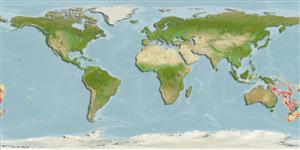Classification / Names
Common names | Synonyms | Catalog of Fishes(genus, species) | ITIS | CoL | WoRMS | Cloffa
Teleostei (teleosts) >
Gadiformes (Cods) >
Macrouridae (Grenadiers or rattails)
Etymology: Coelorinchus: Greek, koilos = a hollow + Greek, rhyngchos = jaw (Ref. 45335); osipullus: Named for the dark gums (Latin os for mouth and pullus meaning dusky or dark colored)..
More on authors: McMillan & Iwamoto.
Environment: milieu / climate zone / depth range / distribution range
Ecology
Marine; bathydemersal; depth range 600 - 1340 m (Ref. 80968). Deep-water
Western Pacific: known only from seamounts of Loyalty and Norfolk ridges, between New Caledonia and New Zealand.
Size / Weight / Age
Maturity: Lm ? range ? - ? cm
Max length : 71.0 cm TL male/unsexed; (Ref. 80968)
Short description
Morphology | Morphometrics
This species is distinguished by the following characters: lacks external evidence of a light organ; anus immediately before anal fin origin; long snout, about 2.5 into head length (HL), anterolateral margins not completely supported by bone; a long band of premaxillary teeth, the outer series only slightly enlarged; fully scaled underside of the head, scales small armed with discrete uniform rows of small spinules; mouth with black gums; body with 10 or 11 wide dark bars or saddles, most do not extend much below lateral midline; bands interrupted by narrow white (pale) spaces oriented vertically or at slightly oblique angles; anal fin with broad, dark distal margins, the anterior part with white distal tips (Ref. 80968).
Life cycle and mating behavior
Maturity | Reproduction | Spawning | Eggs | Fecundity | Larvae
McMillan, P. and T. Iwamoto, 2009. Two new species of Coelorinchus (Teleostei, Gadiformes, Macrouridae) from the Tasman Sea. Proc. Calif. Acad. Sci. 60(4):39-51. (Ref. 80968)
IUCN Red List Status (Ref. 130435)
Threat to humans
Harmless
Human uses
More information
Common namesSynonymsMetabolismPredatorsEcotoxicologyReproductionMaturitySpawningSpawning aggregationFecundityEggsEgg development
Age/SizeGrowthLength-weightLength-lengthLength-frequenciesMorphometricsMorphologyLarvaeLarval dynamicsRecruitmentAbundanceBRUVS
ReferencesAquacultureAquaculture profileStrainsGeneticsElectrophoresesHeritabilityDiseasesProcessingNutrientsMass conversion
Tools
Special reports
Download XML
Internet sources
Estimates based on models
Preferred temperature (Ref.
123201): 3.4 - 4.1, mean 4 °C (based on 5 cells).
Phylogenetic diversity index (Ref.
82804): PD
50 = 0.5000 [Uniqueness, from 0.5 = low to 2.0 = high].
Bayesian length-weight: a=0.00251 (0.00128 - 0.00492), b=3.19 (3.03 - 3.35), in cm total length, based on LWR estimates for this Genus-body shape (Ref.
93245).
Trophic level (Ref.
69278): 3.7 ±0.5 se; based on size and trophs of closest relatives
Resilience (Ref.
120179): Very Low, minimum population doubling time more than 14 years (Preliminary K or Fecundity.).
Fishing Vulnerability (Ref.
59153): Moderate to high vulnerability (48 of 100).
